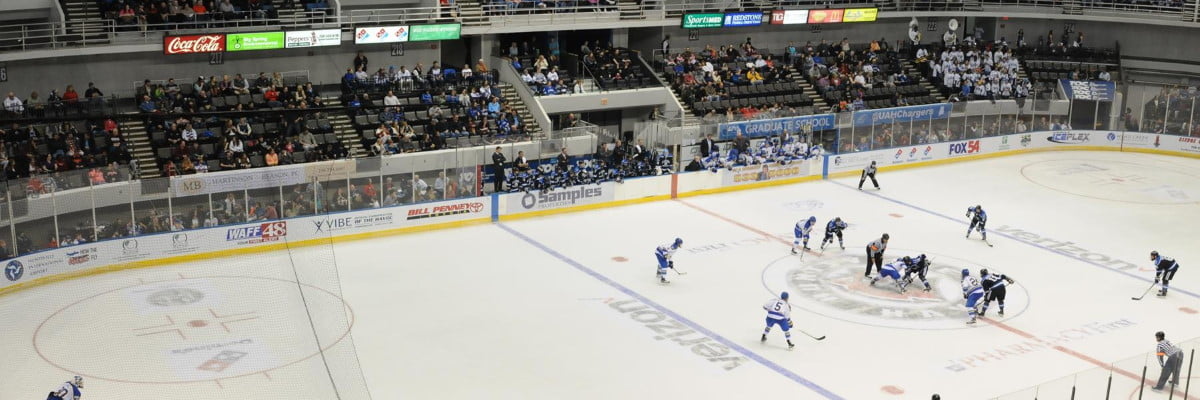The University of Alabama in Huntsville re-affirmed its long-term commitment to its Division I hockey program on Wednesday, collaborating with alumni on a massive pledge while setting goals for conference membership and an on-campus facility.
“This is not a band-aid. This is here long term,” UAH alumnus Taso Sofikitis said in a press conference Wednesday afternoon.
“The UAH hockey program has a long and cherished history,” UAH president Darren Dawson said in the school’s press release. “We are truly grateful for the vital support from our alumni and community as we work together to ensure that the legacy of UAH hockey continues.”
The university, in a partnership with an alumni group headed by Sofikitis and Sheldon Wolitski, are pledging $17 million over 10 years to turn the program into a sustainable model that will compete for championships.
Assisting the alumni group is an advisory committee featuring prominent members of the hockey community, including Nashville Predators president and chief executive officer Sean Henry, Tampa Bay Lightning executive vice president of communications Bill Wickett, and Minnesota Wild goaltender and UAH alumnus Cam Talbot.
“We’re the faces, but there’s a big tribe behind us,” said Wolitski, who along with Sofikitis were defensemen for the Chargers from 1992-96. “My vision expands over the next 10-20 years for not only just Huntsville hockey but hockey in general. My goal is to continue to grow it, because I know it’s going to make a big impact on kids, youth hockey and college hockey, like it’s made for me.”
“That’s the first step: The long-term financial stability,” UAH head coach Lance West said during the WCHA’s preseason teleconference. “There’s been a lot of older guys that have fought for years and now some of the younger guys are stepping up because they can financially. It’s been a very impressive thing to see everybody come together. It’s extremely exciting.”
UAH is about to begin its final season as a member of the WCHA, which will dissolve after this season as seven members are leaving for form the new CCHA, leaving UAH, Alaska Anchorage, and Alaska Fairbanks.
Nevertheless, Smith says he has gotten advice and support from schools such as Minnesota State and Bowling Green, who have been perennial contenders in the WCHA.
“Part of the reason why we’re in this situation is our own fault from the WCHA, and to their credit, some of those people in that league have had really open conversations with me about how things should’ve been done and what needs to be done in the future,” Smith said.
UAH has had conversations with the CCHA and Atlantic Hockey about potentially joining. Atlantic is currently the most likely candidate, and Smith said he has been talking with administrators from across college hockey about what it would take to land a spot. The timeline is secure membership sometime this season.
“We think that this news helps us in that step,” Smith said.
“We have to have a home,” Sofikits said. “We have to have a conference. We’re looking at college hockey. They can see we are committed. Whatever I touch and Sheldon touches, we have to make it a success. Failure is not an option. So we need to show we can be a very valued partner to a conference.”
The new on-campus arena is part of UAH’s master plan, which involves developing a mixed-use area in the 58-acre Executive Plaza along University Drive just west of the campus.
The facility, which would also be a new home for UAH basketball and volleyball, would be subject to approval from The University of Alabama System board of trustees based on “achieving fundraising goals, developing a sustainable business plan, and aligning with UAH’s budget parameters.” UAH announced the proposal in April of 2019 and added to the master plan later that summer.
In the meantime, the Von Braun Center has been helpful by renegotiating their revenue sharing to help UAH. The Huntsville Havoc, which shares the VBC with the Chargers, have also been helpful in game operations and scheduling.
Beyond that, UAH must work on building a program that sustains itself without putting too much of a burden on donors. That will require increasing attendance and corporate sponsorships, and overcoming any perception that nothing has changed from when the hockey program was saved eight years ago.
“There are things already in place that we think are going to generate a lot more revenue,” Smith said. “Any revenue generated from ticket sales, merchandise, or corporate sponsorships, that takes the place of what has been private donations. We don’t want (our donors) to have to foot the bill. That’s not fair. We want this to be a true partnership and working together to where this is something that generates revenue for itself.”
“I’ve been asked, ‘How is it any different than the last time we raised money?’ We have to overcome that,” Wolitski said. “We have a road map to success. It’s not a silver bullet, but there’s a number of things we need to do to prove to the hockey world that we are serious about hockey.”
“There are donors out there that haven’t donated because we haven’t had a strategic plan in place, and we do now. They need to have trust when they donate that it’s going to a good cause, and that’s my job.”
“We’re gonna do whatever it takes to become relevant in college hockey,” Sofikitis said. “If it takes more money, we’re gonna get it done. That’s how passionate we are to take UAH to the next level.”

